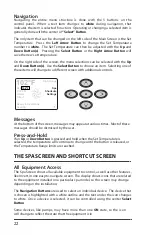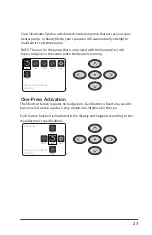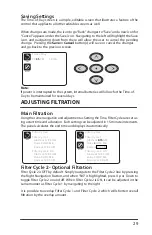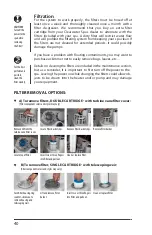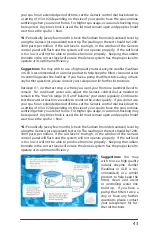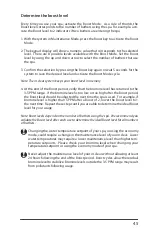
36
The following definitions for chemicals will help you understand what the chemical
is and what it is used for:
Sanitizers
CHLORINE - Chlorine is widely used as a sanitizer in pool and spa water to kill
bacteria, viruses and algae,
it also
oxidizes ammonia and nitrogen compounds
such as swimmer waste. Its formal name is Sodium Dichlor and is referred to as a
chlorinated concentrate. Sodium Dichlor is a fast-dissolving, granular, stabilized
organic chlorine compound providing either 56% or 63% available chlorine.
Cyanuric acid and/or stabilizers are added to prevent U.V. light destruction of the chlo-
rine by the sun.
Use of improper Chlorine additives can cause excessive Cyanuric
acid which can corrode and destroy spa components.
Chlorinated concentrate produces chlorides and chloramines, which are formed
when chlorine has combined with ammonia and nitrogen in pool and spa water.
Chloramines exude a foul, “chlorine” odor and c
an c
ause skin and eye irritation.
BROMINE – Bromine is the other commonly used sanitizer or disinfectant in pool
and spa water to kill bacteria and algae, and oxidizes ammonia and nitrogen com-
pounds such as swimmer waste. This chemical does not eliminate swimmer waste
unless it is combined with an
appropriate
oxidizer
such as a
non-chlorine shock. It
is susceptible
to direct sunlight,
and is
therefore not efficient in outdoor pools.
Bromine is sometimes used as an alternative for people whom are allergic or
sensitive to chlorine products.
Bromine products are available as sodium bromide and bromine tablets. The bro-
mide ion has no effective disinfectant or sanitizing capabilities without the use
of non
-
chlorine shock (potassium monopersulfate). Potassium monopersulfate
is
added to oxidize, or activate,
the
bromide ion
in
to bromine, which rapidly forms
the active sanitizer hypobromous acid in
the
spa water. Upon reaction with
bacteria and other spa contaminants, hypobromous acid is reduced back to
bromide ion, ready to be activated again by the next dose of potassium
monopersulfate.
Potassium monopersulfate begins to produce bromine
immediately and continues to do so for several hours, providing time for
oxidation of bather waste and other organic contamina
nts
such as ammonia and
nitrogen.
NON-CHLORINE SHOCK (Potassium Monopersulfate) – Also known
as “Oxy-
Shock”, is an important chemical used in the process of disinfecting and
sanitizing the spa water. Non-chlorine shock is used to oxidize and eliminate
organic contaminants, dead algae and debris, and will also con-
vert the chlorine
by-products (chlorides and chloramines) back into free available
chlorine.
When used with bromine products, non-chlorine shock is used with sodium bro-
mide in a two-part disinfection system. Potassium monopersulfate (non-chlorine
shock) is added to oxidize, or activate, bromide ion
in
to bromine which rapidly
forms the active sanitizer - hypobromous acid - in spa water. Upon reaction with
bacteria and other spa contaminants, hypobromous acid is reduced back to
bromide ion, ready to be activated again by the next dose of potassium
monopersulfate.
Most non-chlorine shock products have buffers that reduce pH
instability, and corrosion inhibitors that help protect the heater and other metal
surfaces.
Summary of Contents for Beachcraft Series
Page 57: ...57 NOTES...
Page 58: ...58 NOTES...

